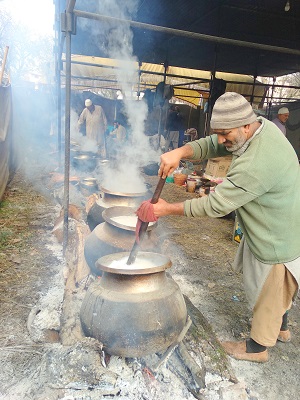Peace Watch » Editor's Take, Featured, Kashmir-Talk, Z. G. Muhammad »

Kashmir Cultural Notes – The Rice-man
Chefs of Kashmir
The Rice-Man
ZGM
Other than politics, which has continuously been picking our minds like woodpeckers on tall pine trees, gossip about wazawan dominates our discourses during the marriage seasons. In olden times, even during our childhood, it comprised seven to nine dishes, and as we advanced in our age, it also started graduating from cuisine to cuisine. Today, on average, the number of the multi-cuisine lamb mutton dishes has gone up to thirty-five- in many cases, more particularly the feast for bridegrooms, the number ranges from fifty to seventy.
In our childhood, chicken dishes were not part of the Wazawan. These perhaps were added to multi-cuisine dishes in the late sixties. Many an expert Ashpazs had then seen it as spoiling to the sanctity of the traditional wazawan. Though our elders before 1947 frequented Peshawar and Lahore, the dishes of these places had not impacted our traditional wazawan. Perhaps, the Chicken was added to Kashmir’s sumptuous feast under the influence of Saudi Arabia. Many chefs from Srinagar after the 1960s went on pilgrimage. It came to be called ‘waza-Kokur’- now more than three chicken dishes have been added to Wazawan. The Chicken is also cooked in the mutton soup like other dishes of Wazawan, including vegetable dishes. These chicken dishes, some cooked in milk or curd, when taken out independently, are quite savouring. Still, amidst the mounds of mutton spread all over the trami that already have vanquished taste buds, they lose supremacy to gratify our palate. Another incongruous item added to traditional wazawan has been pulao; it is served in a separate carved copper bowl and is shared in pinches by four relishing from a common Trami (large tinned copper plate). It at all does not go well with wazawan. It looks like an appendage – a vestige that could easly be scissored to retain the sanctity of wazawan.
In as much cooking of this multi-cuisine feast of Kashmir that has earned a distinctive place to our land in the culinary world is concerned, the Vasta Waza (head chef) is the protagonist and an institution unto himself. It takes him decades of apprenticeship to graduate to be the leader of his team of fifteen to twenty cooks. The number of cooks involved in preparing the feast depends on the quantity of mutton to be cooked. In the lower-middle-class marriages, usually, five to six quintals of meat and one quintal of chickens are cooked. The scene in politically oriented weddings of the wealthy and elite, where lots of politicians and tops in the administration are invited, is different—the quantity of mutton cooked ranges from ten to fifteen quintals. A lot of attention is paid to décor and illuminations. And of late, some politicians and non-resident Kashmir have been booking five-star hotels for marriage ceremonies.
Coming back to Vasta Wazas, through hard labour during their apprenticeship, they master the art of judging the quality of spices. From smelling the spices and other ingredients used in wazawan, they can tell about their quality. Chopping fresh lamb meat for different cuisines is an art that has come to him through experience- it is something worth watching than putting in words. A team of junior wazas, while mincing the meat with heavy-duty cleavers for making kababs in synchronization with the rhythm of wooden mallets of those engaged in pulverizing mutton for making Gustaba and Rista often sing romantic songs of Rasul Mir and add to the festivity of the marriages. This whole job is done under the strict supervision of the Vasta (head chef).
The rice is the primary ingredient of wazawan – it is the staple food of Kashmiris. The rice cooking, which otherwise at homes does not need much an expertize,for wazawan needs unique expertise. Usually, in the wasta waza (chief Chef) team, everyone cannot cook rice- it needs specialization, a minor mistake in its preparation can spoil the entire feast. In old times, the Kashmir valley was known as the rice bowl and was famed for the best indigenous verities. There were almost a hundred varieties of indigenous varieties. For their fragrance and sweetness, some kinds of rice were famed beyond the high mountains of the valley. Some fragrant indigenous varieties like Mushk Bu’deg and Kamad varieties were cooked specially for the feast of the bridegroom. Those who could afford it cooked it for everyone as of late 1970. Historian Dr Sheikh Mohammad Iqbal told me that in Budgam area of Kashmir, some areas were identified for cultivating the special varieties only for the royal courts. Almost all the indigenous rice varieties became extinct after high yield Chinese seeds were introduced in Kashmir. Having lost the fragrant native rice varieties, now the wazas insist on rice cultivated on spring water fed paddy fields. Rice produced in paddy fields irrigated by waters from the famed Kokernag spring in South Kashmir is considered the best. The rice from the spring-fed fields in the ratio of 1:4 mixed with a revived Mushk bu’deg variety is seen as the best variety. Of course, the quality of rice is vital for a good feast, but a lot depends on the Chef cooking the rice.
Let us try as much as we can to preserve our traditional culinary and gastronomic.
Wrote this nostalgia column after two years.
Filed under: Editor's Take, Featured, Kashmir-Talk, Z. G. Muhammad · Tags: @NostalgiaZGM, Kashmir Cultural Notes, My Bioscope, Waza, Wazawan, Z. G. muhammad, ZGM







